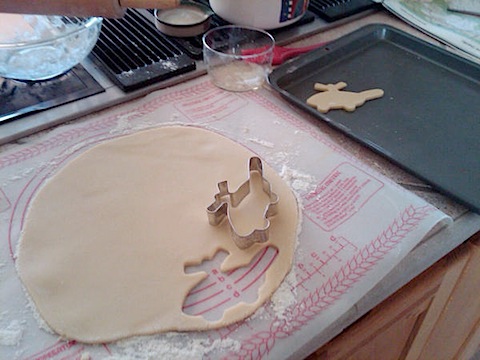I’m blogging this recipe so I don’t lose it. Again.
I found this recipe this past summer when I was stuck in a camper for four months. I made it a few times — a few too many times, if you ask me. Today, when clearing some nonperishable foodstuffs out of the camper, I found the cake flour and remembered it. I immediately wanted to make a cake for my husband to try.
I thought I’d blogged the recipe, but when I went to find it today, it wasn’t in my blog. I probably tweeted it and set a Delicious bookmark for it instead. But I have so many damn bookmarks, a Google search was a quicker way to find it again. I also found a bunch of similar recipes. Now I’m storing the one I used this summer in my blog so I’m sure to find it the next time I want it.
The original recipe was on dizzy-dee.com, which was so overwhelmed with traffic that the recipe (or apparently the whole site) had to be moved. You can now find it, with its photos, at http://blog.vault9.net/food/chocolate-cake-in-5-minutes/. My version is a tiny bit different and I skipped the photos.
Ingredients:
- 4 Tablespoons cake flour (Do not use any other kind of flour if you expect good results.)
- 4 Tablespoons granulated sugar (I tried making this with less sugar and it simply wasn’t sweet enough.)
- 2 Tablespoons unsweetened cocoa
- 1 Egg
- 3 Tablespoons milk
- 3 Tablespoons oil
Instructions:
- Mix the flour, sugar, and cocoa in the largest microwave-safe coffee mug you have. I recommend at least 16 ounces; any smaller and you’re likely to make a mess in your microwave. In a pinch, you could certainly use a 2-cup glass measuring cup.
- Add the remaining ingredients and mix well. Make sure the egg is thoroughly mixed in if you don’t want bits of egg white in your cake.
- Microwave on high for 2-1/2 to 3 minutes, depending on the power of your microwave. This is something you’ll have to test for yourself. My home microwave, which is ancient, is only 700 watts, so 3 minutes was perfect. My camper’s microwave is 1200 watts (for reasons I’ll never understand) and 3 minutes was too long.
- Watch the cake rise out of the top of the cup as it cooks. If the cup is too small, this is when it will overflow and make a mess in your microwave, so you might want to put a paper towel under the cup before you start if the cup isn’t very big.
- When the cake is done, invert the cup onto a plate. If you got the timing right, the cake will be thoroughly cooked, but still moist throughout. If you cooked it too long, the edges will be hard and somewhat dry. Either way, it will be slightly rubbery. But the flavor should be good.
There are other variations of this recipe out on the Web, but this one seems to be the easiest and most consistent, given that all of the ingredients are “raw.” For example, one recipe calls for hot cocoa mix and water instead of the cocoa, sugar, and milk, but every mix is different, so who knows how it might come out?
You’ll find the mug a bit difficult to clean without soaking. I suspect that if you coated it with spray oil and mixed the batter in a different cup before pouring it in to bake, there wouldn’t be a clean up issue. But since I’d rather wash one cup than two when camping, I’ve never tried this.
 Today, I made sugar cookies in the shape of helicopters for my cherry drying clients. It was a lot of work, but worth it. The cookies came out great and I think my clients will get a chuckle when they see them.
Today, I made sugar cookies in the shape of helicopters for my cherry drying clients. It was a lot of work, but worth it. The cookies came out great and I think my clients will get a chuckle when they see them. Roll batter out to 1/4 inch thickness on floured board.
Roll batter out to 1/4 inch thickness on floured board.
 Roll batter out to 1/4 inch thickness on floured board.
Roll batter out to 1/4 inch thickness on floured board. 1 head of
1 head of  Mike and I love creamed spinach. Although we can buy it frozen in a microwaveable bag, we both prefer it fresh. Here’s my microwave-friendly recipe.
Mike and I love creamed spinach. Although we can buy it frozen in a microwaveable bag, we both prefer it fresh. Here’s my microwave-friendly recipe.